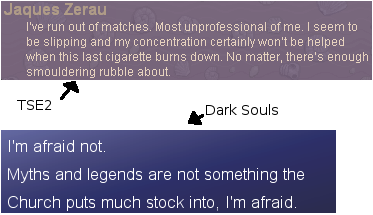Dwelling on Digital Devil Saga
I’ve written up a pair of reviews for this series at videolamer, but I wanted to go into a little bit more about the atmosphere of Digital Devil Saga – because it is nearly perfect for a post-apocalyptic game (with no real-world tie in beyond vague references to global warming). I grabbed the soundtrack for this game, and while I don’t think it’s as good as Shoji Meguro’s work in the Persona series, it’s still pretty solid and brought this to mind.
Digital Devil Saga is depressing, but each game is depressing in a different way. DDS1 deals with death to some degree, but the bulk of the sadness comes from the world rather than individual loss. The Junkyard is a sparse, desolate place where there is an endless rain. No sun shines upon it (even when, near the end, the rain actually stops). Even the clothes its denizens wear are gray, with only a single splash of color to indicate one’s clan. If things weren’t bland enough, even the pupils of the characters are gray (until certain events start occurring, indicating a resurgence of lost emotion – at which point, naturally, their pupils match their hair color).
The colors aside, the landmarks in the junkyard evoke a similar feeling of desolation. Though the fortresses of each clan are impressive, they are not in themselves that interesting. More so are the various non-fortress places you wander; a beached battleship, with a giant rip in its side, a single standing building among several that were torn in half (serving as a temporary hideout), and finally what appears to be an ancient theme park attraction.
Unfortunately, pictures of these areas are not really possible to find via google.
In Digital Devil Saga 2, the focus becomes less on atmosphere (though it is still there) and more on individuals. The new character, Roland, is an old drunkard who is trying to forget a terrible event in his past. The old characters are much better fleshed out (aside from Cielo – who remains a comic-relief Jamaican guy throughout. Apparently there is dialogue that tells his past, but nobody cared enough to mention it in the main story line). Heat, in particular – who is the most expressive character in the first game – is really interesting. He has an incredible, bordering on unrealistic, aggressiveness that is suddenly explained all at once (along with the past of most of the characters). His friendship (?) with Serph becomes strained in most of the first game (he is constantly complaining that Serph is the leader, while he is clearly the strongest). It really becomes a focus in the second game to great effect. It turns DDS2 into a very human – albeit depressing – story.
